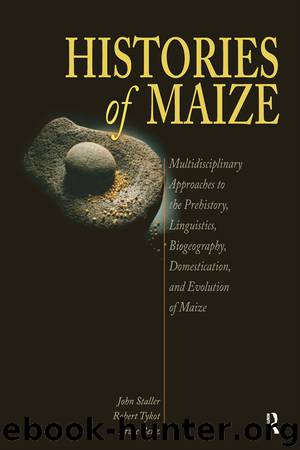Histories of Maize by Staller John; Tykot Robert; Benz Bruce

Author:Staller, John; Tykot, Robert; Benz, Bruce
Language: eng
Format: epub
Publisher: Taylor and Francis
CONCLUSIONS
In conclusion, the spread of maize appears to have been initially tied to its use for sugars, at first from the stalks of teosinte, but later from the maize cobs, kernels, and perhaps other parts. Tentative hypotheses [47, 123] also suggest that early maize was made into fermented beverages related to its high sugar content and only available in a short span of time [47, 123]. This means that the visibility of maize in the archaeological record during the cycle of logistic and residential mobility of an indigenous group is limited and obscure. Maize’s seasonal consumption seems to be tied to sites of extremely low visibility and unstable landscapes such as edges of creeks, rivers, and lakes, as well as inundated floodplains. This narrows the possibility of finding hard evidence of maize to a limited situation in space and time in the yearly cycle of the lives of the hunter–gatherer populations that domesticated maize. These products were used by hunter–gatherer groups in their social lives as a form of gift, whereby reciprocal relations of social and moral obligations could be negotiated and maintained through acts of giving beverages and food during the limited times of social networking or agglomeration common in the dry season. We have to remember the strong tendency of groups to disperse during the rainy season and reunite in the dry season around short times of abundant resources. Maize falls into that spectrum of resource use initially.
The settings of such social activities would have of necessity been tied to territoriality and of small scale given the level of social development and population of such hunter–gatherer groups. It appears that a decrease in territorial ranges and a focus on seasonal plant resources became necessary. Into this scenario the development of ceramics for serving fermented beverages, though not initially verifiable as maize, would have offered another marker of group and territorial identity as reinforced in the gift-giving process. Containers made of other materials were no doubt also used to serve fermented beverages made of maize and other plants. However, the pliability of clay to produce images and symbols may have been vital in its initial origins and spread [103]. Such symbols could mark group identity or ownership over seasonal resources that were not always visible on the landscape or territory of a group [77, pp. 157–164]. The plants, themselves, further may have taken on “special meanings or identities due to their links to places, events and histories” [44, p. 40; also see 23, 24, 125, pp. 74–75].
The subsequent spread of maize and ceramics into Peru seems to be tied to the use of maize in ceremonial contexts, probably in the form of a fermented beverage. The development of maize along the desert coasts of Peru may have helped it to obtain a dominant role as the food–beverage that was offered in ceremonial settings. On the other hand, the humid tropical climates of the Amazon and Orinoco Basins would have hindered maize’s growth and ability to take on a dominant role in social settings of gift exchange in these regions.
Download
This site does not store any files on its server. We only index and link to content provided by other sites. Please contact the content providers to delete copyright contents if any and email us, we'll remove relevant links or contents immediately.
Sapiens: A Brief History of Humankind by Yuval Noah Harari(13981)
The Tidewater Tales by John Barth(12391)
Mastermind: How to Think Like Sherlock Holmes by Maria Konnikova(6934)
Do No Harm Stories of Life, Death and Brain Surgery by Henry Marsh(6683)
The Thirst by Nesbo Jo(6432)
Why We Sleep: Unlocking the Power of Sleep and Dreams by Matthew Walker(6348)
Life 3.0: Being Human in the Age of Artificial Intelligence by Tegmark Max(5182)
Sapiens by Yuval Noah Harari(5117)
The Longevity Diet by Valter Longo(4856)
The Body: A Guide for Occupants by Bill Bryson(4578)
The Rules Do Not Apply by Ariel Levy(4520)
The Immortal Life of Henrietta Lacks by Rebecca Skloot(4248)
Why We Sleep by Matthew Walker(4190)
Animal Frequency by Melissa Alvarez(4148)
Yoga Anatomy by Kaminoff Leslie(4100)
The Hacking of the American Mind by Robert H. Lustig(4080)
All Creatures Great and Small by James Herriot(3980)
Barron's AP Biology by Goldberg M.S. Deborah T(3941)
Double Down (Diary of a Wimpy Kid Book 11) by Jeff Kinney(3921)
